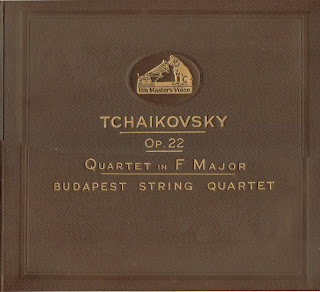The reissue program continues with three recordings by the great Budapest String Quartet, from three different points in their career. First is one of their early recordings, from the time when the Quartet's lineup still boasted two Hungarians, and three of its founding members. These were first violinist Emil Hauser, violist István Ipolyi, and the Dutch cellist Harry Son; the newcomer was second violinist Josef Roisman, a Russian who would eventually become the quartet's leader:
Tchaikovsky: Quartet No. 2 in F, Op. 22 and
Dittersdorf: Quartet No. 6 in A - Minuet
Budapest String Quartet (Hauser-Roisman-Ipolyi-Son)
Recorded February 8, 9 and 11, 1929
HMV Album Series No. 134, five 78-rpm records
Link (FLAC files, 121.83 MB)
Link (MP3 files, 48.98)
By the time of the following recording, Roisman had moved to the first violin chair, and only Ipolyi was left from the original lineup. The Schneider brothers (Alexander and Mischa) now occupied the second violin and cello positions, respectively. This lineup (1932-36) is considered by many to be the Budapest Quartet's greatest, and one of the few recordings from this period that has apparantly never been reissued on LP or CD is this, the only Haydn quartet that the Budapest Quartet was permitted to record for HMV after the Pro Arte Quartet was engaged to do its series for the Haydn Quartet Society. (This particular work had, in fact, been part of the very first Society volume, but that was already out-of-print by the time this release appeared.)
Haydn: Quartet in G, Op. 54, No. 1
Budapest String Quartet (Roisman-Schneider-Ipolyi-Schneider)
Recorded April 24, 1935
Victor Musical Masterpiece Set DM-869, two 78-rpm records
Link (FLAC files, 42.36 MB)
Link (MP3 files, 18.76)
Lastly, here is one of the Budapest Quartet's few recordings of a contemporary work, one actually written for them. Even though Columbia had already successfully launched the LP format by the time of its issue, this recording was issued only on 78s, with the result that it is probably one of the Budapest Quartet's rarest recordings. By this time, Boris Kroyt had long since replaced István Ipolyi as violist (so that now the group consisted entirely of Russians), and Alexander Schneider had left the Quartet in 1944 to freelance. He returned in 1955, but in the meantime a succession of second violinists replaced him; at the time of this recording it was Edgar Ortenberg:
Hindemith: Quartet [old No. 5, new No. 6] in E-Flat
Budapest String Quartet (Roisman-Ortenberg-Kroyt-Schneider)
Recorded April 2, 1945
Columbia Masterworks Set MM-797, three 78-rpm records
Link (FLAC files, 64.08 MB)
Link (MP3 files, 31.15 MB)
A word about the numbering of Hindemith's quartets, which is a very confusing issue indeed! During his lifetime he published six: Op. 10, Op. 16, Op. 22, Op. 32, and two in E-Flat, one in 1943 and one in 1945 - Hindemith stopped using opus numbers after Opus 50. (The present Columbia set doesn't identify a number, merely "Quartet in E-Flat (1943)", but the 1943 quartet was published as "No. 5.") During the 1990s, however, an early Quartet, Op. 2, was published and added to the canon; this - unfortunately - became Quartet No. 1, and the numbers of all the succeeding quartets were bumped ahead by one! Hence, the Op. 22, his most popular, is now known as "No. 4" where it previously was known as "No. 3"; worse still, the 1943 E-Flat is now "No. 6" - while formerly the 1945 quartet was known as "No. 6 in E-Flat"! What I wonder is, why couldn't the Op. 2 quartet have been labelled "No. 0" as with Bruckner's early D minor symphony?

















